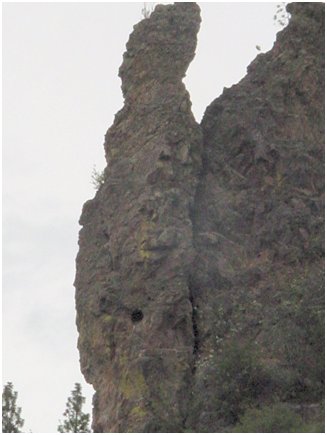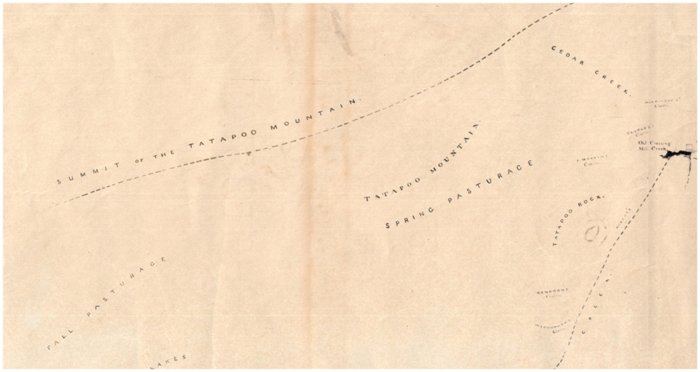By Joe Barreca
When the Hudson Bay Company moved from Fort Colvile (just 2 “l”s) to north of the 49th parallel in 1848 they left a map of their holdings for which they were paid by the US government. (You can see the map for yourself on the CrossroadsArchive.net website by searching for Tatapoo.) The fort itself ended up under a Lake Roosevelt bay just north of St Paul’s Mission. And Tatapoo rock still stands between Kettle Falls and Colville on Highway 395, in a a rock quarry north of the road by mile marker 235. If you look carefully at a spire of rock jutting out of the cliff above this quarry, you will notice a round hole about 2 feet across. That hole dates back to around 1890 and the discovery of the Silver King Mine, the reason Nelson BC is the town it is today.

In Fall of 1886, Charlie Brown, son of a Ferryman and merchant in old Marcus, left with a party of 13 men, that included Osner and Winslow Hall and their 6 sons and his cousin Hamblin (Henry) Oakes, who lived on the hill above Tatapoo Rock to prospect for gold on the Salmon River. Ultimately those sons would have 1.5 million dollars which translates to about 27 million in today’s currency. Enough money that they could afford to waste expensive ammunition trying to drill a hole through this rock by shooting the same spot over and over with their rifles from Winslow Hall’s home across the road from the quarry.
But things didn’t start out with wealth. The Summer of 1886 saw a slump in the local economy. Construction of the Canadian Pacific Railroad finished, the soldiers from Military Fort Colville moved to Fort Spokane and the need for local food to supply workers and soldiers stopped. The weather diminished what crops that did grow to hardly anything.
This group of local farmers, most related to Winslow Hall, decided to go back to something they knew well, prospecting for gold. They headed up to the Salmon River in British Columbia prospecting a tributary now called Hall’s Creek. They cut over a hundred miles of trail prospecting till the grub ran out without striking a claim. As winter moved in, they started packing up to leave. The boys went out to round up their horses, but they couldn’t find them. They sat down and vented their disgust by kicking away vegetation. One of them picked up a rock and chucked it at a pine squirrel as it ran by. Under that rock was a vein of copper-silver ore.
Despite their immediate excitement, they had to disguise their discovery and leave without staking a claim till the next year. The Hall boy’s mother was Indian as were the two hunters in the party. On their way out they encountered another Indian who was paddling downstream in a hurry with a stash of grub he had stolen from a white man’s camp upstream. They convinced him to sell it to them and packed it up for their long trip home.
Back in the Colville Valley, assays proved that their strike was rich with silver and copper. Many neighbors made plans to follow them when they set out in the spring. With a flourish, they filled up merchant Brown’s biggest boats and paddled up the Columbia to the bottom of the Little Dalles where they unloaded again to make the portage around the narrows. But they didn’t make the portage. Instead, they hid in the bushes and watched as a hoard of neighbors scrambled to catch up. After the crowd passed, they packed up a line of horses they had arranged to be waiting there and went around to Metaline on the old Pend Oreille horse trail. Their lead and the trail they built the previous summer secured first choice of claims all over what today is “Toad Mountain” (So named because as Charlie Townsend was filling out a location notice on a claim and pondering what to call the region, a big toad hopped out from under the log he sat on.) The Silver King and associated claims soon attracted a crowd of miners, 3 to 400 of whom lined the banks of Ward Creek in 1888 at what became Nelson BC.
The original party of 13 hired a manager, John McDonald, who forcibly bought out the two pure-blood native hunters of the 1897 discoverers. He arranged passage by steamboat, wagons and rail for the ore and raised investment capital in England and Scotland. Millions of dollars poured into development of the mine and millions more into development of transportation and all the elements of commerce in the area. In 1893 the original discoverers and operators of the Silver King were bought out with cash, stock and stock dividends.
Over the next few years they squandered most of the money. By 1897 the mine itself was worked out Much of the miner’s money went to building up the Colville and Marcus areas and the Hall boys gained a reputation for playing fiddle at all the local dances and of course for spending hours shooting at the hold in Tatapoo Rock.

You can use the mapping app Northeast Washington Insider to lead you to Tatapoo rock and over a hundred other historical locations with their own histories in our corner of Washington. For a long version of this story and many others, read My Home, by Goldie Van Bibber Putnam, available from lulu.com.
